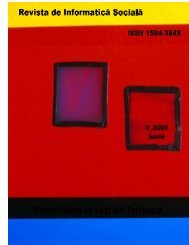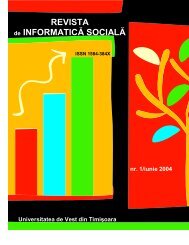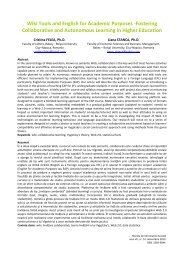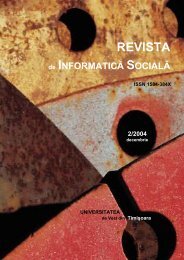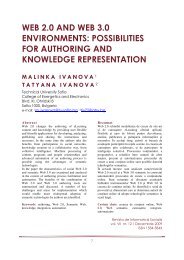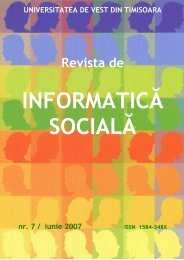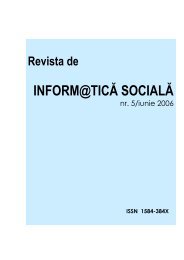No 13 - Journal of Social Informatics / Revista de Informatica Sociala
No 13 - Journal of Social Informatics / Revista de Informatica Sociala
No 13 - Journal of Social Informatics / Revista de Informatica Sociala
Create successful ePaper yourself
Turn your PDF publications into a flip-book with our unique Google optimized e-Paper software.
In such cases, conventional "top down" information as it is produced by journals is or<br />
institutional PR staff is outperformed and marginalized by "bottom up" communications stemming<br />
from individuals who make their own observations and thoughts and who are personally affected<br />
and involved. In comparison to traditional media reporting, a more encompassing and unbiased<br />
overall picture is likely to emerge, because data originate from many different sources - for<br />
individuals and groups located in remote rural places that would never be covered by conventional<br />
mass media reports.<br />
For journalists, therefore, Twitter has the capacity to become one <strong>of</strong> the very primary news<br />
sources that have to be watched permanently in or<strong>de</strong>r to remain in real-time contact with unfolding<br />
events. This is particularly important in cases <strong>of</strong> events that happen unpredictably and in remote<br />
places where no journalists, but only lay users are available for first-hand reporting.<br />
<strong>Journal</strong>ists reporting about ongoing events will be pressed to assume themselves a new role<br />
as “tweeters”. They may earn money by people who become their “followers”: paying fees for<br />
getting the reporters’ short messages just at the time they are watching the unfolding event<br />
(National Press Club 2008). Evi<strong>de</strong>ntly, such journalists are likely to be bombar<strong>de</strong>d with inquiring<br />
requests: so that users become empowered to <strong>de</strong>termine in <strong>de</strong>tail their ongoing work (e.g. the kind<br />
<strong>of</strong> data they are collecting and the kind <strong>of</strong> subjects they will chose for interviewing).<br />
The same capacity <strong>of</strong> instant molecular messaging to subvert formal structures by<br />
un<strong>de</strong>rmining conventional top-down communication could potentially also well be realized within<br />
specific institutions: e. g. scientific congresses or schools .<br />
For instance, Twitter may be used by stu<strong>de</strong>nts for feeding back their immediate reactions to<br />
lecturing teachers. Traditional monological lectures could thus be turned into interactive sessions:<br />
as teachers see tweet messages from their recipients on a screen while they are speaking: providing<br />
an immediate feedback to what they have said 20-30 seconds ago.<br />
By using such potent back channels, much more feedbacks could be expected than un<strong>de</strong>r<br />
conventional settings where stu<strong>de</strong>nts are given the opportunity to ask questions after the speech,<br />
because even shy stu<strong>de</strong>nts will post tweets when they can do it anonymously, and many <strong>of</strong> them can<br />
send postings at the same time because there are no time restrictions as they exist in oral<br />
discussions. Lecturing pr<strong>of</strong>essors would be enabled to adapt very flexibly their presentations by<br />
reacting to messages that ask for more clarification, criticize a specific assertion or propose the<br />
inclusion <strong>of</strong> additional points.<br />
In addition to such bottom-up communication, Twitter could also be used as a tool for<br />
"horizontal whispering" by facilitating stu<strong>de</strong>nt-to stu<strong>de</strong>nt exchanges during formal lessons.<br />
In traditional school settings, stu<strong>de</strong>nts have little opportunity to exchange opinions among<br />
themselves. "Whispering" is usually taboo for two reasons: because it is felt as an acoustical<br />
disturbance and because it manifests a lack <strong>of</strong> due discipline and focused attention.<br />
By means <strong>of</strong> Twitter messages, listeners would have much less obtrusive way for enriching<br />
monological lectures with mutual conversation: e. g. by verifying mutually that they have not well<br />
un<strong>de</strong>rstood certain points, that they all disagree with a specific argument, that they have <strong>de</strong>tected<br />
inconsistencies within the teacher’s presentation or contradictions to what other reputable<br />
knowledge sources say. Thus, recipient listeners can finally eliminate their mutual isolation that<br />
makes them so vulnerable to the teacher's persuasion. School may be well advised to use such<br />
horizontal inter-stu<strong>de</strong>nt exchanges as a resource for improving school learning, instead <strong>of</strong><br />
discouraging and punishing it as an irritating disturbance.<br />
Of course, a very similar empowerment is accruing to TV watchers or radio listeners who<br />
could instrumentalize Twitter for changing from a couch potatoe existence to a much more active<br />
co-participatory role: by feeding back their spontaneous reactions to the emission studio as well to<br />
many other (known or unknown) recipients on a Real-Time basis.<br />
Given the low threshold <strong>of</strong> sending and reading messages, the potential for “flamings” is<br />
even much greater than in the case <strong>of</strong> Email messages or Blog entries (which are similar to<br />
pag. 11: <strong>Revista</strong> <strong>de</strong> Informatică <strong>Social</strong>ă | Vol. III (<strong>13</strong>) / 2010 | ISSN 1584-384X



